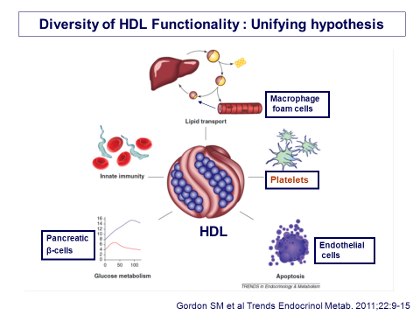Chapman - Figure 3 - Diversity of HDL functions Text
The Proteome
This Figure portrays the diversity of HDL functions as the HDL particles pass throughout the circulation, including the very new feature of HDL “functionality,” which appears to serve as a unifying mechanistic hypothesis.
The perspective of this presentation begins with the diseased state of the arterial wall infected with pathologic, lipid-rich plaques that contain the lipid-rich “target” macrophages that are filled with, among other things, cholesterol. It has been well established that one of the most active features of HDL particles is to remove cholesterol, by the process of efflux through specialized proteins or transporters, out of the macrophages and into the HDL particle. This ensures or protects against macrophages’ becoming foam cells, which are, of course, highly inflammatory and contribute significantly to the pathologic development of the atherosclerotic plaque. Thus a central or primary action of HDL particles is the slowing or even prevention of the accumulation of macrophage foam cells as atherosclerotic plaques progress.
As shown in the Figure, a second feature of HDL functionality is its ability to protect platelets from a hyperaggregatory reaction. In this work performed in Australia[3] a recombinant, or reconstituted, form of HDL was infused into diabetic subjects who displayed hyperaggregatory activity of their platelets – in other words, individuals with a prothrombotic state.
Very interestingly, infusion of this reconstituted form of HDL resulted in almost normalization of platelet hyperactivity, and the mechanism that appears to explain this is depletion of cholesterol from the platelet plasma membrane – ie, by cholesterol efflux, removal of cholesterol from the platelet membrane by HDL particles. Thus again, the efflux activity of HDL particles is critical in modulating cholesterol homeostasis and ultimately, the biological activity of the target cell.
If we now move on the endothelial cells (in the Figure), recent work has shown that HDL particles are able to remove oxidized pro-inflammatory lipids from the surface membrane of endothelial cells. This is particularly important because oxidized lipids can trigger the premature death of endothelial cells, a process known as apoptosis. Here again, it is the cholesterol effluxing activity, or the ability of HDL particles to accept lipids from cells, that results in anti-apoptotic activity and protecting endothelial cells from oxidized lipids.
Even more recently, over the last 2 years, a whole new dimension of HDL particle biology has been discovered that is of tremendous relevance to the development of insulin resistance. It has been shown in several laboratories that HDL particles are able to protect pancreatic beta cells from premature cell death, and again, they appear to be able to do this by removing cholesterol from those cells and maintaining cholesterol homeostasis or balance within them. It has also been shown that HDL can increase the production of insulin by the pancreatic beta cells,
Clearly, then, cholesterol efflux via HDL particles appears to be an essential feature of the protection of pancreatic beta cells and the pancreas in terms of its functionality. This suggests that HDL particles are of major relevance to the development of insulin resistance, and it can be expected that in individuals with low serum HDL levels there will surely be less protection of the pancreatic beta cells.
Finally, there are several reports in the literature that HDL particles are able to contribute to the innate immune reaction, in part by carrying or transporting components of the complement cascade; however, there also appear to be other actions of HDL particles, notably the regulation of the cholesterol content of some cells involved in the immune reaction – both monocytes and macrophages, as well as lymphocytes – that appear relevant to their activities within the context of innate immunity.
In sum, then, there is a large diversity of HDL particle functionality, but of more immediate relevance is that diversity to development of atherosclerosis, to prothrombotic states, to vascular protection, and finally, to protection against the development of insulin resistance. Clearly HDL particles are remarkable, with multiple functional facets, and at the present moment science is just at the beginning of a mechanistic understanding of the multiple protective roles of the HDL particle.
J Clin Lipidol. 2011; 5(6).References
[3]Gordon SM, Hofmann S, Askew DS, Davidson WS. High density lipoprotein: it's not just about lipid transport anymore. Trends Endocrinol. Metab., 22, 9-15 (2011)
